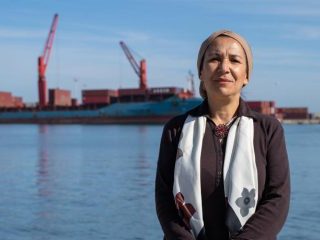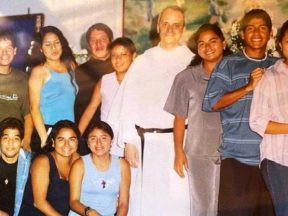Latin America. Liturgical Art at the Service of the Poor.
A Spanish Claretian, for 35 years a missionary in Latin America, Fr. Maximino Cerezo Barredo, now ninety years old, is nicknamed ‘the painter of liberation’ because his artistic work has renewed the sacred iconography of the continent starting from the preferential
option for the poor.
The murals and works of Fr. Maximino have decorated many churches and religious buildings in Latin America. “It is the Latin American context – he tells us – that has put me in close communication with the lowest of society, which produced these works. The world of African Americans, farmers and indigenous people is the one that most influenced me.
I believe that salvation is made present today through the history and life of the poor which is the privileged place in which the real presence
of Jesus is manifested”.
Father Maximino continues: “If I had stayed in Europe, my art would have been different. My path is that of a European who goes to Latin America, identifies himself spiritually and humanly with the world of the poor and, on the basis of what he knows, like a craftsman, expresses what he feels with the images the people provide for him: the faces, attitudes, geography, environment, countryside, rivers, forest, etc.

In his life as an artist, there were various moments that marked his artistic and missionary life. The missionary recalls: “In 1968 in Basilan in the Philippines, I met the Third World, poor and suffering: how could I continue to paint beautiful churches, while those living images of God were exploited and outraged? What was the point of art that ignored the terrible reality of the poor?
Coincidentally, the possibility of founding a Claretian mission in the forest in the San Martín department near the Huallaga River emerged in Peru. Despite the initial opposition of my superiors, I persisted until I was allowed to leave in 1970. I had heard about the General Conference of the Latin American Bishops held in Medellín two years earlier and was in contact with Dom Pedro Casaldáliga, whose booklet I had illustrated of Clamor elemental poems published in Salamanca, Spain, in 1971, but until then I had not been involved in the situation in Latin America”.

“Another key episode occurred a few years later – the priest continues – in the church of Juanjuí, where I had created a mural of 130 square meters entitled The History of Salvation. One day I saw an old woman who, after having observed all the paintings, moving from the image of Adam and Eve to those of the rebellious people, the prophets, Mary and the risen Christ, fell on her knees before the image of a woman crying in front of a dead child in her small coffin, lit a candle and remained some time in prayer. I realized that through the image I had painted, this person was able to get in touch with God. So I discovered that our God reveals himself in the daily lives of people, not only in the great events of history”.In 1977, Father Maximino participated in Medellín in a pastoral course organized by the Latin American Episcopal Council (CELAM) accompanied by liberation theologians such as the Chilean Segundo Galilea, who, however, before the conclusion, were expelled for ideological reasons and replaced, left the course and went for two weeks to Riobamba, Ecuador, with Msgr. Proaño, and a month in São Félix do Araguaia, at a time when the pressure of the military on Dom Casaldáliga was such that he was forced to hide the archives and similar material. “That period confirmed for me the rightness of the line I had to follow, on the pastoral and artistic level: to put myself as a person, priest and artist at the service of the cause of the oppressed”, says the missionary.

The artist-missionary recognized that his art was increasingly influenced by the situation of each people and the means available. Thus, the Magnificat painted in Nicaragua in 1981 was influenced by the fact that the revolutionary process was undergoing the aggression of the United States through the contras and the boycott by the bourgeoisie, while the Catholic hierarchy did not accept what was called the “Popular Church” .
In Venezuela, it is affected by the context of a neighbourhood where thousands of peasants fleeing from the countryside had arrived, and rural elements mixed with those of urban civilization appear in the painting. In the one painted in Luciára, the people of the Brazilian Mato Grosso appear.

Father Maximino considers how people helped him: “I began to understand that the people expressed a world of existential beliefs, which constituted the fabric of their culture, and transmitted Christian values that I believed I had, but did not practise: hospitality, sharing, etc. And that I had to listen. This gradually made me discover another way of understanding the Gospel and the Church, forgetting what I had learned in the seminary to learn little by little from the little ones of the Kingdom, from the practice of faith that I saw in the people. This has also changed my faith”. Looking at today, he believes that there is an artistic movement that is inspired by ecclesial renewal, but it is small and limited to the sphere of basic ecclesial communities, where a true artistic formation is lacking. The great artists, with some exceptions, have no religious concern and consider Christian art as ‘stuff from the sacristy’. There is little interest, unlike what happens in music, which is of immediate use in celebration. Art depends on single individuals.

“Today, however, there is a tendency to return to the icon, considered the highest expression of European religious art. Instead, I try to create a more updated image, starting from the popular world, not for the intellectual and religious elite, but from the people for the people. I believe that sacred art is experiencing a very serious crisis, also because ecclesiastical buildings are not as interesting as in the past. In Europe, then, the process of secularization also carries weight and is not sensitive to the issue of transmitting the Christian message through art”.
He concludes: “Perhaps plastic art is destined to be replaced by digital art. Young people are able to watch images in a video for hours, but they get bored in front of a static art object. The image remains important, but it has shifted from the static and permanent form of a wall or a painting to the realm of the mobile and the virtual”.
Mauro Castagnaro



